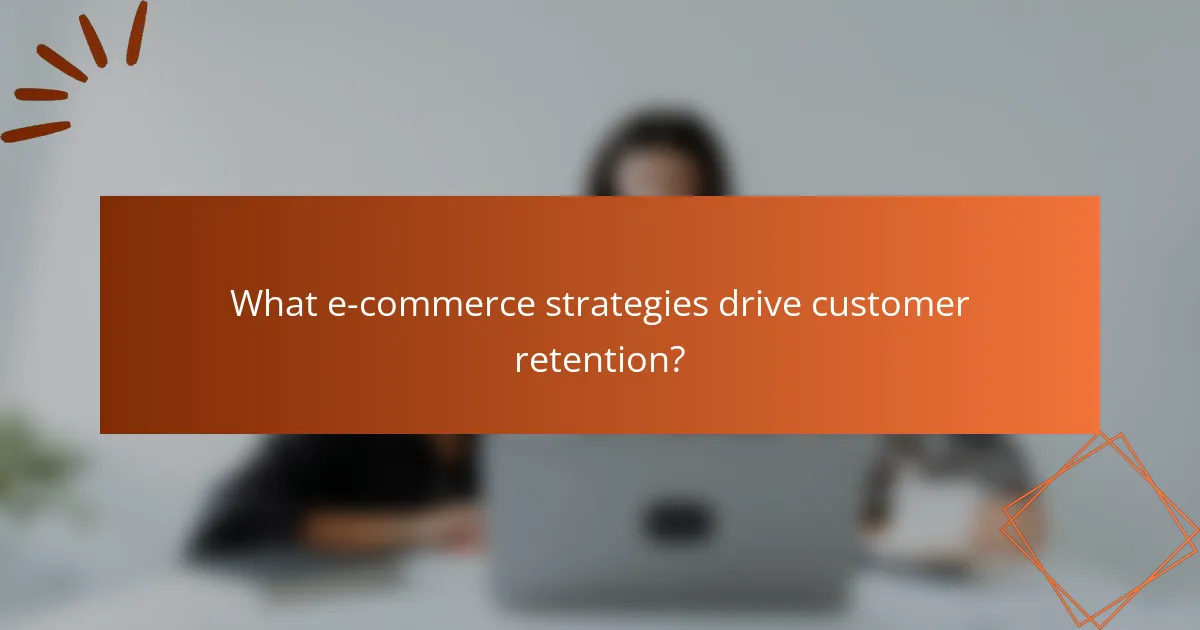Market research services play a crucial role in understanding consumer behavior through techniques like behavioral segmentation, which categorizes customers based on their actions and preferences. By implementing effective e-commerce strategies, such as personalized experiences and loyalty programs, businesses can significantly enhance customer retention and foster long-term relationships. Utilizing data analytics and thorough research methods further refines these strategies, ensuring that companies remain responsive to their customers’ needs.

How can behavioral segmentation improve market research?
Behavioral segmentation enhances market research by categorizing consumers based on their behaviors, preferences, and purchasing patterns. This approach allows businesses to tailor their strategies more effectively, leading to improved engagement and customer satisfaction.
Targeted marketing campaigns
Targeted marketing campaigns leverage behavioral segmentation to reach specific consumer groups with tailored messages. By analyzing data such as purchase history and online activity, companies can create personalized advertisements that resonate with individual preferences. For instance, a clothing retailer might target frequent buyers of athletic wear with promotions for new sports apparel.
To implement targeted campaigns successfully, businesses should utilize data analytics tools to identify key segments and monitor campaign performance. This ensures that marketing efforts are both efficient and effective, maximizing return on investment.
Enhanced customer insights
Enhanced customer insights stem from understanding the behaviors and motivations of different segments. By analyzing how various groups interact with products, companies can uncover trends that inform product development and customer service strategies. For example, a tech company might find that younger consumers prefer subscription models, prompting them to adjust their offerings accordingly.
Regularly updating customer insights through surveys and feedback mechanisms can help businesses stay aligned with evolving consumer preferences. This proactive approach fosters stronger relationships and loyalty among customers.
Increased conversion rates
Increased conversion rates are a direct benefit of applying behavioral segmentation in market research. By targeting the right audience with relevant messaging, businesses can significantly boost the likelihood of purchases. For example, an online store that sends personalized recommendations based on browsing history may see higher sales than one that uses generic promotions.
To maximize conversion rates, companies should continuously test and refine their messaging strategies based on segment performance. A/B testing different approaches can reveal which tactics resonate best with specific groups, leading to more effective marketing efforts.

What e-commerce strategies drive customer retention?
Effective e-commerce strategies that enhance customer retention include personalized shopping experiences, loyalty programs, and customer feedback loops. These approaches foster stronger relationships with customers, encouraging repeat purchases and long-term loyalty.
Personalized shopping experiences
Personalized shopping experiences tailor the online journey to individual preferences, significantly improving customer satisfaction. Utilizing data analytics, businesses can recommend products based on previous purchases, browsing history, and demographic information.
For instance, an e-commerce site might display items similar to those a customer has viewed or purchased, increasing the likelihood of additional sales. Implementing personalization can lead to higher conversion rates, often in the range of 10-30% depending on the industry.
Loyalty programs
Loyalty programs incentivize repeat purchases by rewarding customers for their loyalty. These programs can take various forms, such as point systems, tiered memberships, or exclusive discounts.
For example, a retailer might offer points for every dollar spent, which can later be redeemed for discounts or free products. Effective loyalty programs can boost customer retention rates by 5-10%, making them a valuable investment for e-commerce businesses.
Customer feedback loops
Customer feedback loops involve actively seeking and utilizing customer opinions to improve products and services. This strategy not only helps businesses understand customer needs but also fosters a sense of community and trust.
Implementing regular surveys, reviews, and feedback requests can provide insights into customer satisfaction and areas for improvement. Businesses that effectively respond to feedback often see enhanced loyalty and retention, as customers feel valued and heard.

What are the best practices for market research services?
The best practices for market research services include leveraging data analytics, conducting thorough surveys and interviews, and implementing A/B testing. These methods help businesses understand consumer behavior, refine strategies, and enhance customer retention effectively.
Utilizing data analytics tools
Data analytics tools are essential for interpreting large sets of consumer data and identifying trends. By employing software like Google Analytics or Tableau, businesses can gain insights into customer preferences, purchasing patterns, and market dynamics.
When selecting a data analytics tool, consider factors such as ease of use, integration capabilities, and cost. A well-chosen tool can streamline data collection and analysis, enabling quicker decision-making.
Conducting surveys and interviews
Surveys and interviews provide direct feedback from customers, offering qualitative insights that data alone may not reveal. Use online platforms like SurveyMonkey or Typeform to create engaging surveys that capture customer opinions and experiences.
To maximize response rates, keep surveys concise and focused. Aim for a mix of multiple-choice and open-ended questions to gather both quantitative and qualitative data. Follow up with interviews for deeper insights when necessary.
Implementing A/B testing
A/B testing involves comparing two versions of a product, webpage, or marketing strategy to determine which performs better. This method allows businesses to make data-driven decisions based on real user interactions.
When conducting A/B tests, ensure that you have a clear hypothesis and a sufficient sample size to achieve statistically significant results. Common areas for A/B testing include email campaigns, landing pages, and product pricing strategies.

How to choose a market research service provider?
Choosing a market research service provider involves assessing their expertise, technology, and client feedback. Focus on their ability to deliver insights that align with your specific business needs and objectives.
Evaluating expertise and experience
When evaluating a market research provider, consider their industry experience and specialization. Look for firms that have successfully conducted projects similar to yours, as this indicates familiarity with your market dynamics.
Ask about their team’s qualifications, including educational backgrounds and relevant certifications. A provider with a diverse team can offer varied perspectives, enhancing the quality of insights.
Assessing technology and tools used
Examine the technology and tools the provider employs for data collection and analysis. Advanced analytics platforms and data visualization tools can significantly enhance the quality of insights derived from your research.
Inquire about their methodologies, such as whether they use qualitative or quantitative approaches, and how they ensure data accuracy. Providers using cutting-edge technology often deliver more reliable and actionable insights.
Reviewing client testimonials
Client testimonials provide valuable insights into a provider’s reliability and effectiveness. Look for case studies or reviews that highlight successful outcomes and specific metrics achieved through their services.
Consider reaching out to previous clients for direct feedback. This can give you a clearer picture of the provider’s strengths and weaknesses, helping you make a more informed decision.

What are the costs associated with market research services?
The costs associated with market research services can vary significantly based on the type of research, the complexity of the project, and the specific methodologies employed. Typically, businesses can expect to invest anywhere from a few thousand to tens of thousands of dollars depending on their needs.
Pricing models for different services
Market research services often use several pricing models, including project-based fees, hourly rates, and subscription services. For example, project-based fees might range from USD 5,000 to USD 50,000, while hourly rates for consultants can vary from USD 100 to USD 300.
Subscription models are becoming increasingly popular, especially for ongoing research needs. These can range from USD 500 to USD 5,000 per month, depending on the depth and frequency of the insights provided.
Factors influencing service costs
Several factors influence the costs of market research services, including the scope of the research, the target audience, and the data collection methods used. For instance, qualitative research methods like focus groups may be more expensive due to the need for skilled moderators and participant incentives.
Geographic location also plays a role; services in larger urban areas may command higher prices due to increased operational costs. Additionally, the urgency of the project can affect pricing, with expedited services typically costing more.


